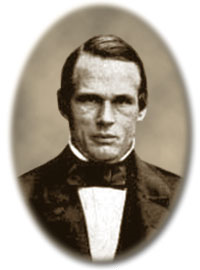 Andres Jonas Angstrom, born on the 13th of August 1814 at Sweden, and was educated at Uppsala University where he was appointed private docent in 1839. It was in 1842 that he went to Stockholm Observatory to gain experience in practical astronomical work. In the following year, 1843, he was appointed keeper of the Astronomical Observatory in Uppsala. He became interested in terrestrial magnetism, and was tasked by the Stockholm Academy of Sciences to work out the magnetic data obtained by the Swedish frigate ?Eugenie? during its voyage around the world from 1851 to 1853.
Andres Jonas Angstrom, born on the 13th of August 1814 at Sweden, and was educated at Uppsala University where he was appointed private docent in 1839. It was in 1842 that he went to Stockholm Observatory to gain experience in practical astronomical work. In the following year, 1843, he was appointed keeper of the Astronomical Observatory in Uppsala. He became interested in terrestrial magnetism, and was tasked by the Stockholm Academy of Sciences to work out the magnetic data obtained by the Swedish frigate ?Eugenie? during its voyage around the world from 1851 to 1853.
He was able to complete the task given to him just shortly before his death. He took over the post of Adolph Ferdinand Svanberg as chair of physics at the Uppsala University in 1858. To date, his most valuable work was his study of the conduction of heat and spectroscopy. His studies earned him the Rumford medal of the Royal Society in 1972 and he was honored to be one of the founders of spectroscopy.
In line with astronomy, he conducted researches that involve the solar spectrum. His study of the spectroscope combined with photography, yielded his discovery that the sun?s atmosphere consists of hydrogen, among other elements. He published a map of the normal solar spectrum, Recherches sur le spectre solaire that included detailed measurements of 1000 spectral lines. In 1867, he became the first astronomer to examine the spectrum of the aurora borealis or the northern lights.
He had a son named Knut Johan Angstrom who also became a physicist and a professor of the same science as with his father, at Stockholm University in 1885. His son also made a name of his own, and was known for his invention of the electric compensation pyrheliometer and the apparatus for obtaining the photographic representation of the infra-red spectrum. There were many honors named after Andres Jonas Angstrom like the Angstrom Laboratory at the Uppsala University. The Angstrom unit, used in crystallography and spectroscopy was also named after him. The crater named Angstrom that was found on the moon was also named for his honor.
